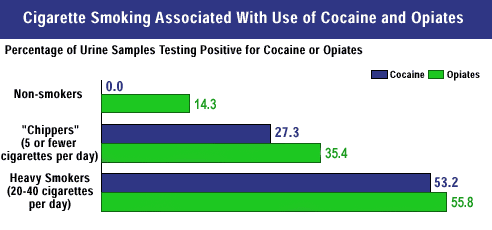|
People who abuse drugs are also likely to be cigarette smokers. More than two-thirds of drug abusers are regular tobacco smokers, a rate more than double that of the rest of the population. NIDA researchers have found that craving for nicotine appears to increase craving for illicit drugs among drug abusers who also smoke tobacco, and this relationship suggests that smokers in drug treatment programs may be less successful than nonsmokers in staying off drugs.
At NIDA's Intramural Research Program in Baltimore, Dr. Stephen Heishman and his colleagues examined the interaction of craving for nicotine and craving for other drugs and found that situations that increased desire to smoke also increased desire to use drugs. The study involved male and female adult smokers who were not trying to stop smoking and had histories of abusing alcohol, cocaine, heroin, marijuana, and/or other substances.
The researchers asked participants to listen to recorded scripts describing scenes and then to rate their urge to smoke and their desire to use other drugs. In the first part of the study, which involved 18 participants, the scripts had content that was generally pleasant (watching children on a sunny beach), unpleasant (a friend asking to borrow money), or neutral (doing household chores). Some scripts also included people expressing a desire to smoke, while others did not mention smoking at all (see "Cues Trigger Craving"). Both the scripts including a mention of smoking and those containing negative emotional content increased the participants' craving for drugs, as well as for smoking.
 Among patients in a methadone treatment program for opiate addiction, levels of cocaine or opiate use were directly related to levels of cigarette smoking. |
In the second part of the study, 24 participants heard scripts with only pleasant content (enjoying the beach, talking on the phone with an old acquaintance, or visiting friends). These scripts also contained descriptions of tobacco craving that increased in intensity from no mention of smoking to asking the question, "How could you really enjoy yourself fully unless you were smoking?" Participants reported that craving for both drugs and tobacco increased as the intensity of the tobacco craving messages in the scripts increased.
"One of our more interesting findings was that scripts that elicited craving for tobacco also elicited craving for the subject's drug of choice. This suggests that real-world situations that produce tobacco craving also may result in craving for drugs of abuse," Dr. Heishman says. The findings also suggest that treatment for heroin, cocaine, or alcohol addiction might be more effective if it included concurrent treatment of tobacco addiction, he says.
In a NIDA-supported study at the University of California, San Diego, doctoral candidate Dominick Frosch and his colleagues at the Integrated Substance Abuse Program at the University of California, Los Angeles, investigated the relationship between levels of cigarette smoking and levels of cocaine and heroin use among 32 individuals who had been in a methadone treatment program for at least 4 months. The participants included 10 nonsmokers (6 female, 4 male) and 22 smokers (16 female, 6 male). The smokers were equally divided among heavy smokers (20 to 40 cigarettes per day) and "chippers" who smoked 5 or fewer cigarettes per day. "Compared with heavy smokers, chippers have less intense craving for their first cigarette of the day and can more comfortably avoid smoking in situations where it is not permitted," Mr. Frosch explains.
The researchers evaluated the connection between tobacco smoking and illicit drug use among the smokers and nonsmokers by using breath and urine samples from the participants over a 7-day period. They found that the amount of cocaine and heroin use was closely related to the level of tobacco use. "The more cigarettes smoked, the more likely the person was to use illegal drugs," Mr. Frosch says. "These findings provide compelling reasons for implementing smoking cessation programs for patients in methadone treatment, as the benefits of smoking cessation may extend to opiate addiction as well."
Sources
Taylor, R.C.; Harris, N.A.; Singleton, E.G.; Moolchan, E.T.; and Heishman, S.J. Tobacco craving: intensity-related effects of imagery scripts in drug abusers. Experimental and Clinical Psychopharmacology 8(1):75-87, 2000.
Frosch, D.L.; Shoptaw, S.; Nahom, D.; and Jarvik, M.E. Associations between tobacco smoking and illicit drug use among methadone-maintained opiate-dependent individuals. Experimental and Clinical Psychopharmacology 8(1):97-103, 2000.
|